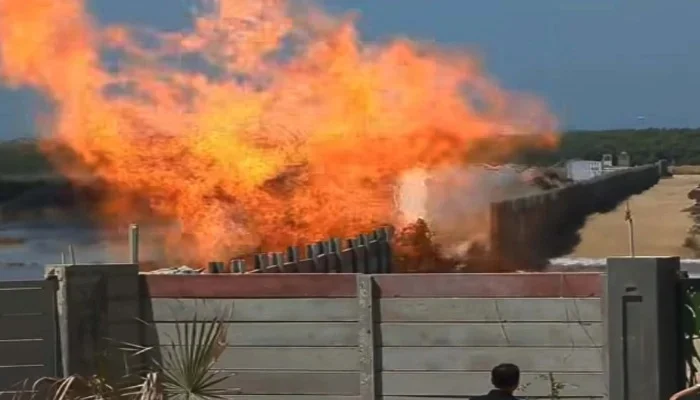Authorities have decided to enlist the help of a globally renowned US-based firm to assist in extinguishing the underground fire in Karachi’s Korangi Creek area, suspected to be caused by a natural gas pocket, sources informed Geo News.
Amid growing concerns over the blaze that has persisted for the past 12 days, the Ministry of Energy (Petroleum Division) has established a technical committee to assess and contain a natural gas pocket discovered in Karachi’s Korangi Creek area.
The committee comprises Chief Operating Officer of Pakistan Petroleum Limited (PPL) Sikandar Ali Memon, along with Oil and Gas Development Company Limited (OGDCL) Chief Geologist Khurrum Shahzad, Production Manager Habibullah Chohan, and General Manager of Pakistan Refinery Limited (PRL) Abdul Majid as its members.
According to sources, the technical committee has also resolved to procure two state-of-the-art gas detection meters to accurately measure the presence and concentration of natural gas in the affected area, the sources added.
Furthermore, experts are also considering the option of filling the boreholes with cement as part of their strategy to contain the fire, they added.
Moreover, the PRL has been instructed to immediately establish a camp office on its premises, and all energy, petroleum, and service companies operating in Sindh have been urged to provide the necessary technical and logistical support to aid in firefighting and remedial operations.
The fire’s flame, which was initially blue, has now turned reddish, indicating incomplete combustion and the emission of carbon monoxide.
The fire originated after a 1,200-foot-deep bore was drilled at the site on March 29, raising concerns about the type and volume of gas fueling the blaze.
A preliminary chemical analysis, according to PPL sources, of the water emanating from the ditch at the Korangi fire site revealed the presence of hazardous chemicals.
The initial report, compiled after water sampling from the fire site, detected excessive levels of benzene, toluene, and tetrachloroethylene.
The report indicated that tetrachloroethylene was measured at 33 micrograms per liter, significantly exceeding the standard limit of 5 mg. Benzene concentrations were recorded at 19 mg per liter, also surpassing the permissible threshold of 5 mg.
Similarly, toluene was found at 15 micrograms per liter, three times higher than the recommended safety level. Additionally, a slightly elevated quantity of o-xylene was also detected in the water sample, although the exact amount was not specified.
However, the preliminary findings indicated that the overall hydrocarbon content in the water was within permissible limits.
Furthermore, investigations are underway to determine the extent to which the detected chemicals are attributable to toxic waste being dumped via the Malir River and subsequently absorbed into the ground.
Specialized companies exist for managing such fires; however, there has been no update on whether authorities have contacted any such company or undertaken efforts to develop a contingency plan or conduct a study to assess the size of the gas reservoir.



